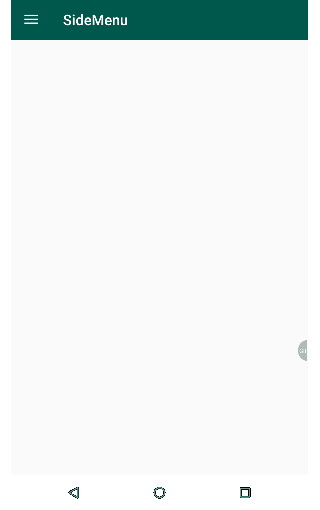
今天要學習如何使用 DrawerLayout
首先先到 build.gradle 中加入
dependencies {
...
implementation 'com.android.support:design:28.0.0'
}
基本上在一個 DrawerLayout 之中,會有一個 NavigationView 來顯示選單和一個 layout 來顯示主畫面(左邊選單收起後的畫面)
所以先修改一下我們的 activity_main.xml 檔案:
activity_main:
<?xml version="1.0" encoding="utf-8"?>
<android.support.v4.widget.DrawerLayout xmlns:android="http://schemas.android.com/apk/res/android"
xmlns:app="http://schemas.android.com/apk/res-auto"
android:id="@+id/drawer"
android:layout_width="match_parent"
android:layout_height="match_parent">
<android.support.constraint.ConstraintLayout
android:layout_width="match_parent"
android:layout_height="match_parent"
android:orientation="vertical">
...
</android.support.constraint.ConstraintLayout>
<android.support.design.widget.NavigationView
android:id="@+id/navigationView"
android:layout_width="wrap_content"
android:layout_height="match_parent"
android:layout_gravity="start"
android:background="@android:color/white"
app:headerLayout="@layout/drawer_header"
app:menu="@menu/drawer_items" />
</android.support.v4.widget.DrawerLayout>
由於我們想要自訂顯示在 DrawerLayout 中主畫面顯示的內容,所以這邊建立一個 toolbar 來取代預設的 ActionBar (畫面上方類似標題列的東西)。
在資源檔中加入一個 layout 檔
<?xml version="1.0" encoding="utf-8"?>
<android.support.v7.widget.Toolbar xmlns:android="http://schemas.android.com/apk/res/android"
xmlns:app="http://schemas.android.com/apk/res-auto"
android:id="@+id/toolbar"
android:layout_width="match_parent"
android:layout_height="wrap_content"
android:fitsSystemWindows="true"
android:minHeight="?attr/actionBarSize"
app:theme="@style/ThemeOverlay.AppCompat.Dark.ActionBar"
android:background="@color/colorPrimaryDark"/>
fitsSystemWindows 這個屬性只對 rootView 有作用,表示範圍可以延伸到整個畫面(狀態列上)
再來回到 activity_main,將放置主畫面的 ConstraintLayout 修改為:
<android.support.constraint.ConstraintLayout
android:layout_width="match_parent"
android:layout_height="match_parent"
android:orientation="vertical">
<include
layout="@layout/toolbar"
android:layout_width="match_parent"
android:layout_height="wrap_content" />
<FrameLayout
android:id="@+id/container"
android:layout_width="match_parent"
android:layout_height="match_parent"
app:layout_behavior="@string/appbar_scrolling_view_behavior" />
</android.support.constraint.ConstraintLayout>
標籤表示我們要加入一個 layout 檔,達到 layout 檔建立好後可以重複使用的效果
下方的 FrameLayouut 是要拿來放主畫面中除了 ToolBar 之外要顯示的東西
另外由於我們要使用自訂的 ToolBar 來取代預設的 ActionBar ,所以還要到 res/values/styles.xml 中修改系統主題為 Theme.AppCompat.Light.NoActionBar
否則會出現已經有一個 ToolBar 的報錯提示。
再來要開始設定左方的選單列,首先從最上方的 Header 開始:
<?xml version="1.0" encoding="utf-8"?>
<android.support.constraint.ConstraintLayout xmlns:android="http://schemas.android.com/apk/res/android"
android:layout_width="match_parent"
android:layout_height="100dp"
android:background="@color/colorPrimaryDark"
android:theme="@style/Base.ThemeOverlay.AppCompat.Dark">
<TextView
android:layout_width="match_parent"
android:layout_height="match_parent"
android:gravity="center_vertical"
android:text="Header"
android:textSize="30sp" />
</android.support.constraint.ConstraintLayout>
設定好後,回到 activity_main ,將 app:headerLayout="@layout/navigation_header" 這個屬性設定給 NavigationView
<android.support.design.widget.NavigationView
android:id="@+id/navigationView"
android:layout_width="wrap_content"
android:layout_height="match_parent"
android:layout_gravity="start"
android:background="@android:color/white"
app:headerLayout="@layout/navigation_header"
app:menu="@menu/drawer_items" />
下一步是設定選單中的項目,注意這個資源檔是屬於 menu 類別,需要在 res 資料夾中新增 menu 資料夾,然後再加入

xml 如下:
<?xml version="1.0" encoding="utf-8"?>
<menu xmlns:android="http://schemas.android.com/apk/res/android">
<group android:checkableBehavior="single">
<item android:id="@+id/item01"
android:title="Item 1"
android:icon="@drawable/ic_android_black_24dp"/>
<item android:icon="@drawable/ic_android_black_24dp"
android:id="@+id/group1"
android:title="Group 1">
<menu>
<group>
<item android:id="@+id/group1_1"
android:title="group 1-1"
android:icon="@drawable/ic_android_black_24dp"/>
<item android:id="@+id/group1_2"
android:title="group 1-2"
android:icon="@drawable/ic_android_black_24dp"/>
<item android:id="@+id/group1_3"
android:title="group 1-3"
android:icon="@drawable/ic_android_black_24dp"/>
</group>
</menu>
</item>
<item android:icon="@drawable/ic_android_black_24dp"
android:id="@+id/group2"
android:title="Group 2">
<menu>
<group>
<item android:id="@+id/group2_1"
android:title="group 2-1"
android:icon="@drawable/ic_android_black_24dp"/>
<item android:id="@+id/group2_2"
android:title="group 2-2"
android:icon="@drawable/ic_android_black_24dp"/>
<item android:id="@+id/group2_3"
android:title="group 2-3"
android:icon="@drawable/ic_android_black_24dp"/>
<item android:id="@+id/group2_4"
android:title="group 2-4"
android:icon="@drawable/ic_android_black_24dp"/>
<item android:id="@+id/group2_5"
android:title="group 2-5"
android:icon="@drawable/ic_android_black_24dp"/>
<item android:id="@+id/group2_6"
android:title="group 2-6"
android:icon="@drawable/ic_android_black_24dp"/>
</group>
</menu>
</item>
</group>
</menu>
思路為每一個 item 中還能再加入 group 把許多 item
給包起來(注意 group 和 item 之間還需要放一個 menu 標籤)
接著如同 Header 作法,到 Navigation 的屬性中多加入 app:menu="@menu/drawer_items"
最後所有建立好的 layout 都要放到主介面中使用,完整的 xml 如下:
<?xml version="1.0" encoding="utf-8"?>
<android.support.v4.widget.DrawerLayout xmlns:android="http://schemas.android.com/apk/res/android"
xmlns:app="http://schemas.android.com/apk/res-auto"
android:id="@+id/drawer"
android:layout_width="match_parent"
android:layout_height="match_parent">
<android.support.constraint.ConstraintLayout
android:layout_width="match_parent"
android:layout_height="match_parent"
android:orientation="vertical">
<include
layout="@layout/toolbar"
android:layout_width="match_parent"
android:layout_height="wrap_content" />
<FrameLayout
android:id="@+id/container"
android:layout_width="match_parent"
android:layout_height="match_parent"
app:layout_behavior="@string/appbar_scrolling_view_behavior" />
</android.support.constraint.ConstraintLayout>
<android.support.design.widget.NavigationView
android:id="@+id/navigationView"
android:layout_width="wrap_content"
android:layout_height="match_parent"
android:layout_gravity="start"
android:background="@android:color/white"
app:headerLayout="@layout/navigation_header"
app:menu="@menu/drawer_items" />
</android.support.v4.widget.DrawerLayout>
現在把畫面都設定好了,但還不能讓我們的功能完整呈現,接下來要處理選單按鈕和事件的處理。
首先在 MainActivity 中的 onCreate ,我們希望用程式做出漢堡選單的按鈕
override fun onCreate(savedInstanceState: Bundle?) {
super.onCreate(savedInstanceState)
setContentView(R.layout.activity_main)
val toggle = ActionBarDrawerToggle(
this,
drawer,
toolbar,
R.string.drawer_open,
R.string.drawer_close
)
drawer.addDrawerListener(toggle)
toggle.syncState()
setSupportActionBar(toolbar)
navigationView.setNavigationItemSelectedListener {
Toast.makeText(this, it.itemId.toString(), Toast.LENGTH_LONG).show()
when (it.itemId) {
R.id.item01 -> {
changeFragment(it.title.toString(), Item1Fragment())
drawer.closeDrawers()
}
R.id.group1_1 -> {
changeFragment(it.title.toString(), Group1_1Fragment())
drawer.closeDrawers()
}
}
true
}
}
字串資源,name 是關鍵字,不能任意修改:
<resources>
<string name="app_name">SideMenu</string>
<string name="drawer_open">Open navigation drawer</string>
<string name="drawer_close">Close navigation drawer</string>
</resources>
接著還要覆寫 onOptionsItemSelected 這樣漢堡選單按了才有功能
override fun onOptionsItemSelected(item: MenuItem?): Boolean {
when (item?.itemId) {
android.R.id.home -> drawer.openDrawer(GravityCompat.START)
}
return super.onOptionsItemSelected(item)
}
延續上個步驟,我們寫一個方法來處理 Fragment 之間的切換
這裡練習使用 Bundle 把 title 資訊帶過去
fun changeFragment(title: String, fragment: Fragment) {
var bundle = Bundle()
bundle.putString("MainActivity", title)
fragment.arguments = bundle
fragmentManager.beginTransaction().replace(R.id.container, fragment).commit()
}
在 create view 時,從 arguments 中取出資料並把值指定給 UI
class Item1Fragment : Fragment() {
override fun onCreateView(inflater: LayoutInflater, container: ViewGroup?, savedInstanceState: Bundle?): View? {
val v = LayoutInflater.from(context).inflate(R.layout.fragment_layout, container, false)
val bundle = arguments
val result = bundle!!.getString("MainActivity")
v.textView.text = result
return v
}
}
